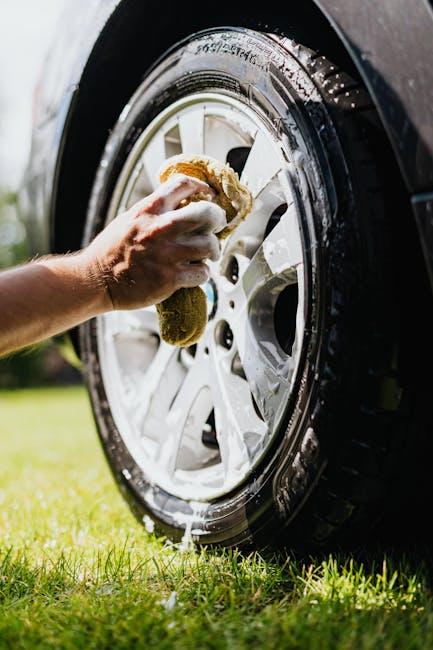Your vehicle is more than just a mode of transportation; it’s a trusted companion on countless journeys, from daily commutes to spontaneous road trips. Yet, like any reliable partner, it requires care and attention to keep running smoothly. One of the most common questions drivers face is: how often should you service your vehicle? Striking the right balance between maintenance and mileage can save you from unexpected breakdowns, costly repairs, and even improve safety on the road. In this article, we’ll explore the factors that influence service intervals and help you understand how to keep your car in peak condition without unnecessary visits to the workshop.
Table of Contents
- Understanding the Importance of Regular Vehicle Servicing
- Factors That Influence Your Vehicle’s Service Interval
- Signs Your Car Needs Immediate Attention
- Manufacturer Recommendations Versus Real-World Driving Conditions
- Choosing Between Routine Maintenance and Comprehensive Servicing
- Tips for Keeping Track of Your Vehicle’s Service Schedule
- Q&A
- In Conclusion

Understanding the Importance of Regular Vehicle Servicing
Regular vehicle servicing is more than just a routine—it’s a crucial step in ensuring the longevity and reliability of your car. Neglecting this can lead to unexpected breakdowns, costly repairs, and reduced safety on the road. A well-serviced vehicle not only runs efficiently but also helps maintain its resale value, giving owners peace of mind and a smoother driving experience. Technicians thoroughly inspect key components such as brake systems, engine oil, filters, and tires, addressing minor issues before they escalate into major problems.
Key benefits of consistent servicing include:
- Enhanced fuel efficiency
- Improved vehicle safety
- Prevention of costly repairs
- Optimized engine performance
- Prolonged vehicle lifespan
| Service Interval | Common Tasks |
|---|---|
| Every 5,000 – 7,500 miles | Oil & filter change, tire check |
| Every 15,000 miles | Air filter replacement, brake inspection |
| Every 30,000 miles | Transmission fluid change, thorough engine check |

Factors That Influence Your Vehicle’s Service Interval
Various elements can affect how frequently your vehicle needs professional attention. One primary aspect is your driving habits. Frequent short trips, heavy traffic conditions, or aggressive driving can cause more wear and tear, requiring more frequent check-ups to maintain optimal performance. Additionally, the environment in which you drive plays a significant role; dusty or salty roads can accelerate corrosion and clog filters, making routine inspections and timely replacements essential.
Another factor is the vehicle’s age and mileage. Newer models with advanced engineering might boast longer intervals thanks to improved materials and technology, while older vehicles could demand a closer eye to prevent breakdowns. Also, consider the manufacturer’s recommendations, but tailor them to fit your unique situation. The table below outlines some commonly affected parts and suggested service intervals affected by these factors:
| Vehicle Component | Normal Conditions | Severe Conditions |
|---|---|---|
| Engine Oil | 10,000 km / 6 months | 5,000 km / 3 months |
| Air Filter | 15,000 km | 10,000 km |
| Brake Fluid | 24 months | 12 months |

Signs Your Car Needs Immediate Attention
Ignoring the subtle hints your vehicle gives can quickly turn a minor inconvenience into a costly repair. Some of the most urgent indicators to watch for include unusual noises like grinding or screeching from the brakes, sudden jolts or vibrations while driving, and warning lights flashing persistently on your dashboard. These signs often signal underlying mechanical issues that demand prompt diagnosis to avoid being stranded or facing severe engine damage.
Additionally, you should never overlook changes in fuel efficiency or fluid leaks underneath your car. These symptoms can point to problems with your fuel system, engine seals, or coolant hoses. To help you quickly assess the severity of these signals, here’s a quick guide that outlines common symptoms alongside their possible causes and immediate actions to take:
| Symptom | Possible Cause | Recommended Action |
|---|---|---|
| Grinding brake noise | Worn brake pads | Immediate brake inspection |
| Engine warning light | Sensor failure or engine issue | Diagnostic test ASAP |
| Sudden oil leak | Damaged seal or gasket | Stop driving, seek repair |

Manufacturer Recommendations Versus Real-World Driving Conditions
While manufacturers provide service intervals based on controlled testing environments, real-world driving conditions often challenge these recommendations. Factors such as frequent stop-and-go traffic, extreme temperatures, dusty roads, and heavy hauling can accelerate wear and tear on critical components. For instance, a vehicle driven primarily in urban areas may require oil changes and brake inspections more frequently than one only used for highway cruising. In some cases, following a strict manufacturer schedule may leave minor issues unnoticed, increasing the risk of breakdowns or costly repairs.
To tailor maintenance effectively, consider these real-world factors:
- Climate (hot, cold, humid, or dry environments)
- Driving style (aggressive versus gentle acceleration)
- Road conditions (paved roads versus gravel or off-road)
- Frequency and length of trips (short errands versus long-distance travel)
| Condition | Recommended Service Adjustment |
|---|---|
| Severe heat & dusty roads | Service intervals cut by 20-30% |
| Mostly highway driving | Service intervals can often be extended |
| Frequent towing or heavy loads | More frequent fluid and brake checks required |

Choosing Between Routine Maintenance and Comprehensive Servicing
Deciding whether your vehicle needs routine maintenance or a more comprehensive service can significantly affect its longevity and performance. Routine maintenance typically includes essential checks such as oil changes, tire rotations, and brake inspections, aimed at preserving your car’s current condition and preventing minor issues from escalating. These tasks are generally quicker and less costly, keeping your vehicle running smoothly with minimal downtime.
In contrast, a comprehensive service dives deeper into the mechanical and electronic systems of your vehicle, often involving detailed diagnostics, fluid replacements, and parts adjustments or replacements. This type of servicing is ideal for older vehicles, those with high mileage, or when preparing your car for seasonal changes. Below is a comparison table to help you understand the key differences:
| Service Type | Typical Tasks | Recommended For | Frequency |
|---|---|---|---|
| Routine Maintenance |
|
Newer or low mileage vehicles | Every 5,000-10,000 miles |
| Comprehensive Service |
|
Older vehicles or pre-trip checks | Annually or every 20,000-30,000 miles |

Tips for Keeping Track of Your Vehicle’s Service Schedule
Keeping a close eye on your vehicle’s maintenance timetable is essential for ensuring longevity and peak performance. One effective strategy is to utilize digital tools like maintenance apps or calendar reminders, which help you stay ahead of key dates without scrambling at the last minute. Additionally, maintaining a dedicated physical logbook inside your glove compartment can be invaluable, especially during visits to different service centers. This simple habit ensures that every oil change, tire rotation, or filter replacement is documented and easy to reference. Consistency is key—regularly updating your records prevents missed services and catches issues before they become costly repairs.
Another helpful approach is to categorize tasks based on mileage and time intervals, making it easier to visualize when to perform specific services. Use the following table as a rough guideline to keep your schedule organized and manageable:
| Service Type | Mileage Interval | Time Interval |
|---|---|---|
| Oil & Filter Change | Every 5,000 – 7,500 miles | Every 6 months |
| Tire Rotation | Every 7,500 miles | Every 6 months |
| Brake Inspection | Every 10,000 miles | Annually |
| Coolant Flush | Every 30,000 miles | Every 2 years |
- Set recurring reminders on your phone or computer
- Keep service receipts and notes organized for quick access
- Consult your owner’s manual for manufacturer-specific guidance
Q&A
Q:
A: The frequency of vehicle servicing depends on several factors including the make and model of your car, your driving habits, and the manufacturer’s recommendations. Generally, most vehicles benefit from a check-up every 10,000 to 15,000 miles or roughly once a year. However, some cars with complex technology or severe driving conditions might require more frequent attention.
Q: Why is regular servicing important?
A: Regular servicing keeps your vehicle running smoothly, improves safety, enhances fuel efficiency, and helps prevent costly repairs down the road. Think of it as giving your car a health check—spotting minor issues before they turn into major breakdowns.
Q: Can I rely on the “check engine” light to know when to service?
A: The “check engine” light is an important alert but isn’t a substitute for scheduled maintenance. Many routine services like oil changes, brake inspections, and fluid top-ups won’t necessarily trigger this warning but are vital for your vehicle’s longevity.
Q: What should a typical service include?
A: A standard service usually involves an oil and filter change, checking and replacing fluids, inspecting brakes, tires, and belts, testing battery health, and ensuring the lights and signals are functioning correctly. Your mechanic may also scan for any hidden engine codes.
Q: Should I follow the servicing schedule in the owner’s manual?
A: Yes! Your vehicle’s owner manual is the best place to start. Manufacturers design maintenance schedules based on their specific engine designs and parts. Following these guidelines helps maintain warranty coverage and keeps your car performing optimally.
Q: Does driving style affect how often I should service my vehicle?
A: Absolutely. Frequent short trips, city driving, extreme weather conditions, or towing heavy loads put extra stress on your vehicle, often requiring more frequent servicing. Keeping track of these factors helps you tailor your maintenance routine more precisely.
Q: Is DIY servicing a good idea to save time and money?
A: While some basic tasks like topping up windshield washer fluid or replacing air filters can be safely done at home, professional servicing ensures that trained eyes catch issues you might miss. Plus, modern vehicles often need specialized diagnostic tools that only service centers have.
Q: What happens if I neglect regular servicing?
A: Skipping scheduled maintenance can lead to decreased fuel economy, increased emissions, reduced safety, and ultimately expensive repairs. Ignoring small issues often allows them to escalate into larger problems, affecting your vehicle’s reliability and resale value.
Q: How can I keep track of my vehicle’s service history?
A: Keeping a detailed logbook, using maintenance apps, or relying on your dealership’s digital records helps ensure you never miss important service intervals. This record is also a valuable asset when selling your vehicle, proving it has been well cared for.
By tuning into your vehicle’s needs and following a thoughtful service routine, you’re not just maintaining a machine—you’re preserving a trusty companion for the journeys ahead.
In Conclusion
In the end, your vehicle’s service schedule isn’t just a line on a calendar—it’s a rhythm that keeps your journey smooth and safe. While manufacturers offer guidelines, tuning into your car’s unique needs and driving habits ensures you’re not just maintaining a machine, but nurturing a trusted companion on the road. So, whether you’re a weekend explorer or a daily commuter, regular check-ups are your best bet for uninterrupted adventures and peace of mind behind the wheel. Remember, when you care for your car, it shows up ready to take you wherever life leads.
